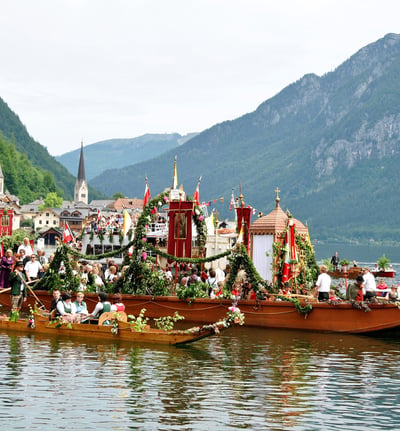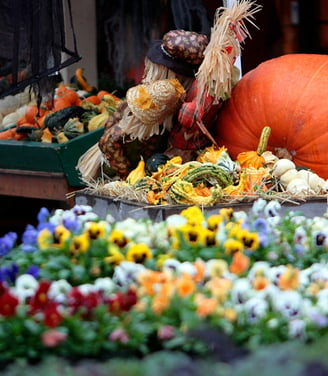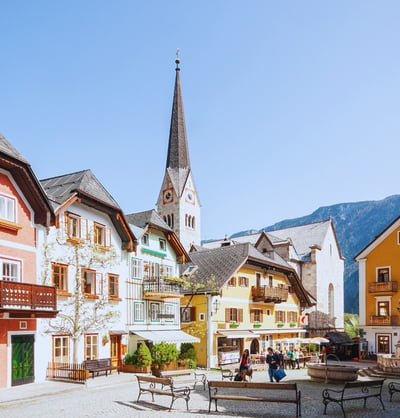Hallstatt 2025: Timeless Beauty, Ancient Salt Mines, and Cultural Highlights


Nestled between the serene Hallstätter See and the towering Dachstein mountains, Hallstatt is a picturesque village that has captivated travelers for centuries. Recognized as a UNESCO World Heritage site, this Austrian gem is renowned for its ancient salt mines, breathtaking landscapes, and rich cultural heritage. In 2025, Hallstatt continues to enchant visitors with its timeless charm and a vibrant calendar of events that celebrate its history and traditions.


Hallstatt’s Ancient Legacy
Hallstatt’s history spans over 7,000 years, making it one of Europe’s oldest continuously inhabited settlements. Its significance in the ancient salt trade earned it the title of “white gold capital,” and the Hallstatt Salt Mine remains a must-visit destination.
Hallstatt Salt Mine: Journey Through 7,000 Years of History
The Hallstatt Salt Mine, or Salzwelten Hallstatt, is often referred to as the world's oldest salt mine still accessible to visitors. With evidence of salt mining dating back to the Neolithic era, this vast network of tunnels offers a deep dive into humanity's early interaction with the natural world. Guided tours lead visitors through ancient passages where miners once harvested "white gold" by hand, showcasing primitive tools and preserved remnants of prehistoric life. The experience includes a ride down a wooden miner's slide and access to a subterranean salt lake, which glows ethereally under the cavern light.
Above ground, the Hallstatt Skywalk adds a breathtaking dimension to the journey. From 360 meters above the village, travelers are treated to a panoramic vista of the Hallstatter See and the Dachstein Alps. The contrast between ancient labor underground and serene alpine beauty above serves as a powerful reminder of how deeply Hallstatt is woven into both the human and natural landscapes.
Hallstatt Museum: A Treasure Trove of Archaeological Wonders
Tucked within the village center, the Hallstatt Museum holds a stunning collection of artifacts uncovered from local salt mines and Iron Age burial grounds. As the namesake of the Hallstatt Culture (circa 800–400 BCE), the museum provides an immersive window into early European society. Visitors can view elaborately crafted ceramics, tools, and textiles that once served daily life in this mountain village. Interactive displays bring these ancient artifacts to life, offering rich context through storytelling and multimedia.
Beyond showcasing relics, the museum tells the broader story of Hallstatt's role in shaping Central Europe. Educational exhibits reveal the village's economic and cultural links with distant regions, underscoring its importance as a trade hub long before modern borders were drawn. It's a place where history is not just preserved, but felt.
Ossuary Chapel (Beinhaus): A Unique Testament to Local Traditions
The Ossuary Chapel, located within St. Michael's Chapel, houses one of the most poignant and distinctive memorials in Europe. Known locally as the Beinhaus, this sacred space contains over 1,200 human skulls, each carefully arranged and many adorned with floral motifs and names written in delicate script. This tradition began in the 12th century when burial space became scarce, leading locals to exhume remains and respectfully preserve them in this hauntingly beautiful ossuary.
Far from being morbid, the Beinhaus offers a deeply reflective experience. The intimate scale and artistry of the ossuary speak to a worldview where death is not an abrupt end, but a continuation of one’s presence within the community. It stands as a quiet meditation on time, memory, and the care we extend to our ancestors.
Natural Wonders and Outdoor Adventures
Hallstatter See is more than a scenic backdrop—it's a living canvas that mirrors the rhythms of the village. Its glassy surface reflects the timbered houses of Hallstatt and the ever-changing moods of the sky, making it one of Austria's most photographed natural settings. Whether gliding across its waters by traditional boat or watching swans drift silently by, visitors are drawn into a state of serene contemplation.
Beyond its beauty, the lake invites exploration. In summer, it becomes a playground for swimmers, kayakers, and anglers. In the colder months, mist rolls over its surface like something from folklore. Paths around the lake reveal quiet corners perfect for photography or peaceful reflection, and the lakefront restaurants offer front-row seats to nature’s daily performances.
Hallstatt’s natural beauty is unparalleled, offering visitors a chance to immerse themselves in its tranquil surroundings.
Just beyond Hallstatt, the Dachstein Krippenstein plateau unfolds a dramatic alpine landscape punctuated by otherworldly ice caves and towering peaks. The Ice Caves are a surreal spectacle, filled with glittering frozen waterfalls and towering ice formations that change with the seasons. Expert guides explain the geology and folklore behind each icy chamber, turning the tour into a journey through natural history.
After exploring the depths, visitors can ascend to the 5 Fingers viewing platform—a set of cantilevered walkways that jut over a 400-meter drop, offering one of the most thrilling panoramic views in the Alps. Whether basking in the silence of ancient ice or standing breathless above the clouds, Dachstein Krippenstein provides an unforgettable contrast of wonder.


Hallstatter See: A Mirror of Alpine Splendor
Dachstein Krippenstein & Ice Caves: A Subterranean Marvel
A short drive from Hallstatt lies the Gosau Valley, home to the Upper and Lower Gosau Lakes. Encircled by jagged peaks and dotted with wildflowers in warmer months, these alpine lakes feel like something out of a dream. The reflection of the Dachstein glacier in their waters creates perfect symmetry for photographers, while well-maintained hiking trails offer access to views that shift with every turn.
Gosausee isn't just about scenery—it's a portal into the soul of the Salzkammergut region. Along the trails, visitors encounter rustic huts offering homemade alpine cheeses and elderflower drinks. Wildlife such as marmots and chamois may appear along ridgelines, reminding hikers of nature's quiet presence. Whether walking, cycling, or simply breathing the crisp mountain air, the Gosau Lakes invite a deep exhale.
No visit to Hallstatt is complete without a stop at the Classic Village Viewpoint—the very image most associated with Austria on postcards and social media. From here, one captures the entire tableau: pastel houses perched beside the lake, the slender spire of the Lutheran church, and snow-dusted peaks standing guard above. At sunrise, the view glows gold; at twilight, it softens to blue and pink.
While popular, the viewpoint retains its magic through silence. Arriving early or lingering after the daytrippers depart allows for a more private communion with the scene. Photographers may come for the image, but many stay for the moment—that instant when Hallstatt feels entirely your own.


Gosau Lakes: A Photographer's Paradise
Classic Village Viewpoint: Capturing Hallstatt's Iconic Image
Hallstatt's most unique religious celebration unfolds not in a cathedral but upon the lake itself. Each year on the Feast of Corpus Christi, the community decorates boats with flowers, crucifixes, and banners, transforming them into floating altars. The clergy, choir, and townspeople board the boats for a solemn procession across Hallstatter See, their reflections gliding with them on the still water.
It's a moment that defies time—ancient and yet alive. Visitors are welcome to observe respectfully from the shores or follow the procession by boat. The event speaks volumes about Hallstatt's intimate relationship with its landscape and its ability to transform even the simplest setting into something sacred.


Hallstatt 2025: A Year of Cultural Celebrations
Classic ViHallstatt Salt Festival — July 15–17, 2025
Corpus Christi Procession on Lake Hallstatt — May 29, 2025
Hallstatt’s cultural calendar in 2025 is filled with events that showcase its traditions and community spirit.
The Salt Festival honors the very resource that built Hallstatt—salt, the "white gold" that once fueled an empire. Held in mid-July, the festival brings the village to life with pageantry, music, and craft. Visitors can watch traditional salt-mining demonstrations, often performed in period costume, and enjoy folk performances that range from alpine yodeling to intricate Schuhplattler dances.
Culinary booths line the streets with salt-rubbed meats, fresh-baked pretzels, and regional delicacies seasoned with local herbs. Artisans showcase woodcarving, embroidery, and ceramics, turning the town square into a living museum. For a few days each summer, Hallstatt remembers who it is—and invites the world to remember with it.
As the highlands glow with golden leaves and vineyards grow heavy with grapes, Hallstatt hosts its annual Harvest Festival. It's a time to give thanks for the region’s bounty and to honor rural traditions that still shape local life. Farmers' markets brim with apples, cheeses, and wild mushrooms, while stalls offer steaming mugs of Sturm (young wine) and pumpkin soup.
Live performances from brass bands and folk troupes bring warmth to crisp autumn days. Children participate in grape-stomping contests, and workshops teach visitors how to press apples or bake sourdough. It is a season of celebration and slowing down—when the village offers not just beauty, but belonging.


Christmas in Hallstatt — December 1–24, 2025
Autumn Harvest Festival — September 23–25, 2025
During Advent, Hallstatt transforms into a scene from a snow globe. Twinkling lights illuminate wooden chalets, and the smell of gingerbread and gluhwein drifts through the cobblestone alleys. The Christmas Market features handmade toys, ornaments, and woolens crafted by local artisans, each booth aglow with candlelight.
Special events include evening lantern walks through the historic district and choir concerts in the Lutheran church. Ice skating on the frozen lake or a ride in a horse-drawn sleigh completes the winter fairytale. In Hallstatt, Christmas is not commercial—it's heartfelt, wrapped in snow and memory.
To make the most of your visit to Hallstatt, consider these expert tips:
Best Time to Visit: Spring and autumn offer pleasant weather and fewer crowds.
Getting There: Hallstatt is accessible by train and ferry from Salzburg or Vienna, providing a scenic journey through Austria’s landscapes.
Accommodation: Stay overnight to experience Hallstatt’s peaceful mornings and evenings.
Hidden Gems: Venture beyond the main attractions to discover the Lutheran Church and the Capuchos Convent.
Local Cuisine: Don’t miss trying Hallstatt’s traditional pastries and dishes at lakeside restaurants.


Insider Travel Tips for Visiting Hallstatt in 2025
Hallstatt in 2025 is not merely a destination—it is a meditation on time. In its salt-stained tunnels and candlelit ossuaries, in its mirrored lake and lantern-lit alleys, one finds more than beauty: one finds stillness. A sense that the world can pause, that the past can breathe beside us, and that culture is not something preserved in glass cases, but lived—softly, and daily.
Whether you come seeking ancient echoes, alpine air, or the warmth of music by a wood-carved stall, Hallstatt invites you to do one simple thing: stay present. Linger by the lake. Listen to the bells. Walk slowly through the streets where miners, monks, and mothers once stepped. In Hallstatt, the mountains don’t just watch over you—they remember.
Final Thoughts
References (for further reading and verification):
Corpus Christi Procession — "A Unique Tradition on Lake Hallstatt."
Hallstatt Salt Festival — "Celebrating Austria’s White Gold Heritage."
Autumn Harvest Festival — "Agricultural Traditions in Hallstatt."
Christmas in Hallstatt — "Festive Season in Austria’s Most Photogenic Village."
Hallstatt Museum — "Exploring the Hallstatt Culture."
Hallstatt's enduring connection to its ancient salt mines reveals a story of resilience and cultural heritage that shaped this captivating village. Delve into this remarkable journey in Desinations — "Hallstatt: Reflections of an Ancient Salt Kingdom."
In the stillness of Hallstatt’s surroundings, the gentle chime of bells intertwines with a traveler’s reflections, evoking moments of quiet wonder and connection. Explore this heartfelt reverie in Travelers' Tales — "The Silence Between Bells: A Hallstatt Reverie."
✉️ Contact:
Curated by TrueTrip Hub |
© 2025 Invisible Atlas — All rights reserved.
Invisible Atlas
Journey Beyond the Visible
invisible.atlas@truetriphub.com
